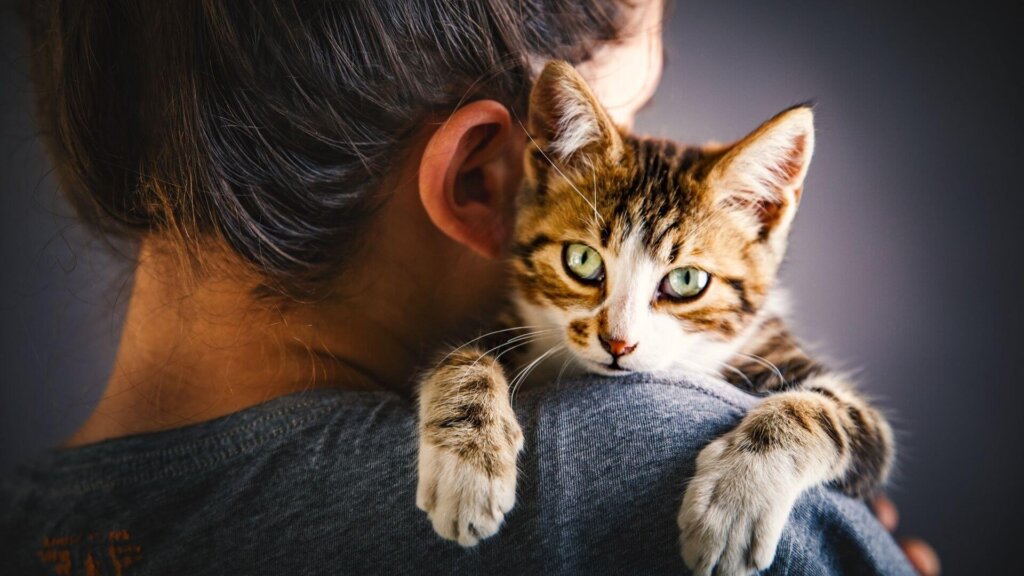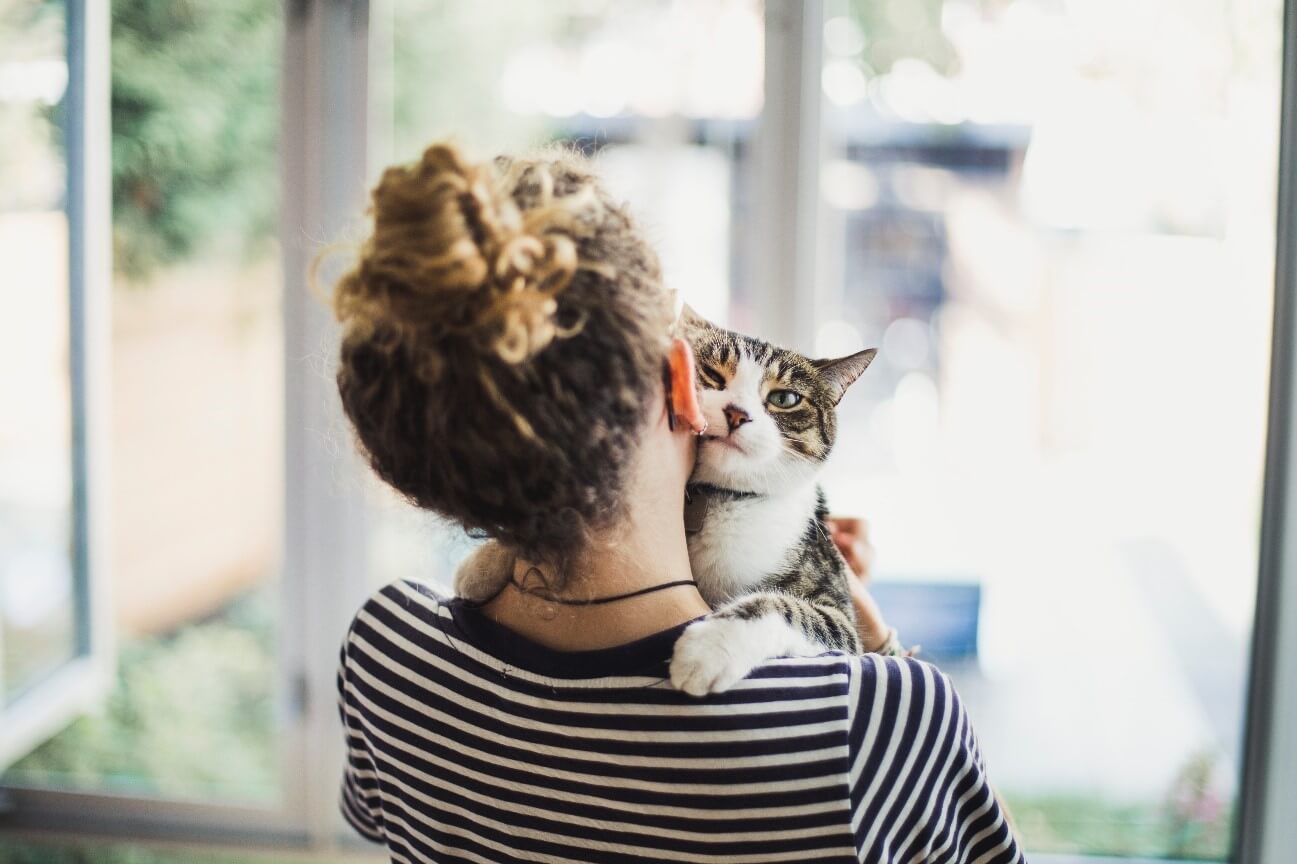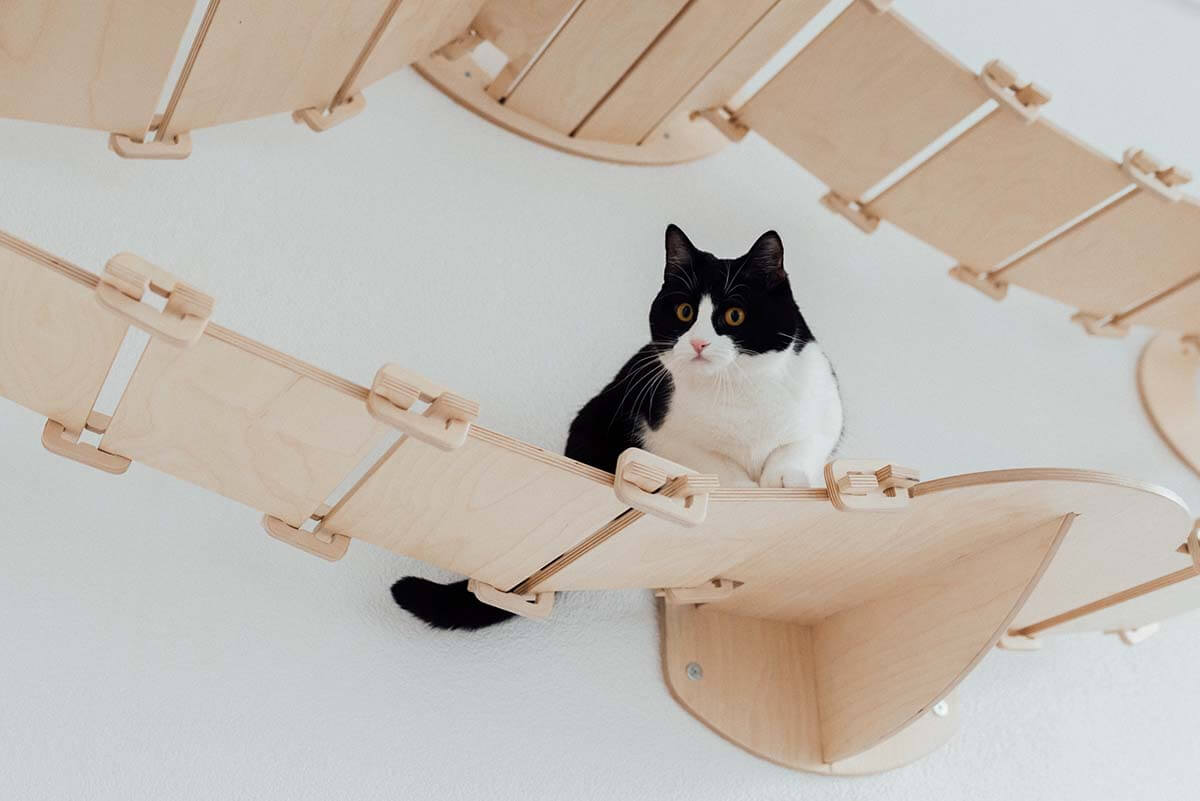Hyper-Attachment in Cats: Causes, Signs, and Solutions

Since their domestication some 10,000 years ago, the relationship between cats and humans has evolved to the point where they’re considered a fundamental part of the family in many households. While such interactions have proven to be beneficial for both species, they can sometimes turn into unhealthy relationships. Such is the case with hyper-attachment in cats.
This type of behavior – characterized by an obsessive dependence of the pet on its guardian – leads animals to demand constant attention. In addition, felines may experience fear, insecurity, and anxiety when they’re alone.
If you’re interested in knowing the causes of this disorder, the behaviors that identify it, as well as some strategies to manage it effectively, be sure to read the following article.
Cats and social interactions
According to a publication in the journal PNAS, the domestication of the species began in the territories of the Middle East during the Neolithic era. At this time, wild felines, from which the domestic cat descends, began to approach agricultural settlements due to the high availability of rodents for hunting.
Seeing the benefit of this behavior, the settlers opted to welcome them into their homes and established mutually beneficial relationships.
An article in the journal Nature Ecology & Evolution suggests that this phenomenon – unlike what happened with dogs – didn’t considerably alter the morphological, physiological, and behavioral characteristics of felines.
However, a study published in 2019 has suggested that, as with humans and canines, cats develop bonds of attachment with their caretakers.
The study in question, published in the journal Current Biology, analyzed the behavior of 70 cats between 3 and 8 months of age. After conducting different experiments, they concluded that the species can manifest two types of attachment:
- Secure attachment: Manifests when the guardian supplies the cat’s physiological and emotional needs from an early age. It’s a healthy bond in which the pet feels trust and security. Therefore, it interacts with unfamiliar people or animals. In addition, it enjoys the company of its guardian and doesn’t feel fear or anxiety when they’re absent.
- Insecure attachment: This occurs when cats have grown up in unhealthy environments and conditions with little or no socialization. The animals are wary of interactions with strangers. They may be very solitary or very demanding of their guardians, to the point of being dependent and suffering from separation anxiety.

Why won’t my cat leave my side?
As a publication in the Journal of Veterinary Behaviour states, attachment is a natural behavior necessary for the survival of all mammalian species.
Its function is to maintain proximity and contact with another animal – usually the mother – during the early stages of life. The objective is to obtain protection and body warmth. However, when this behavior continues into adulthood and is accompanied by emotional dependency behaviors, the attachment is considered pathological.
Cats that develop insecure bonds with people are more likely to suffer from hyper-attachment.
This means that if your cat doesn’t want to be separated from you for a single moment, it may not be a simple matter of love and affection, but the animal may be experiencing a behavioral disorder.
Among the risk factors or causes for a feline to exhibit this behavior, the following can be mentioned:
- Mistreatment during the early stages of life
- Poor socialization with animals or humans at early ages
- Overprotection by the guardian
- Isolation and poor sensory stimulation
- Lack of attention as a kitten
The symptoms of hyper-attachment in cats
It’s important to emphasize that not all cats that are close to their guardians suffer from a behavioral problem. When reference is made to a cat with hyper-attachment, certain signs or symptoms associated mainly with separation anxiety are observed.
In this regard, and as stated in an article in the journal PLoS One, the following symptoms should be considered:
- The destruction of objects in the home
- Excessive vocalization (meowing)
- Urination and defecation in inappropriate places
- Depression and apathy when the guardian comes home or when alone
- Excessive agitation and anxiety in the same scenarios
- Obsessive licking resulting in hair loss (feline psychogenic dermatitis)
- Constant demands for attention
What to do if my cat has hyper-attachment?
Bearing in mind that several of the symptoms presented by dependent cats are manifested in other types of diseases, such as FLUTD, taking your pet to the veterinarian to rule out any type of physiological disease should be the first measure to be taken.
If no pathology is diagnosed, the next step should be to consult with an ethologist or professional in feline behavior. They will initially be in charge of correcting the pet’s behavior.
At the same time, according to a publication in the Journal of the American Veterinary Medical Association, guardians can adopt certain strategies for the treatment of behavioral disorders. These include the following:
- Training: Encouraging and rewarding positive behaviors allows the relationship between a cat and its guardian to be strengthened. In addition, the attention and sensory stimulation provided during training will prevent the cat from developing anxious behaviors in different scenarios.
- Don’t physically or verbally abuse the cat: Ignoring unwanted behaviors in the cat may worsen the misbehavior. Similarly, it’s important to avoid scolding and physical punishment if the pet is very dependent or clingy. This could generate even more distress.
- Modify and enrich the environment: The inclusion of games, scratching posts, platforms, tunnels, and other available objects stimulate the senses and entertain the cat in those moments when it must be left alone. In addition to this, they encourage and strengthen their natural instincts, so that their attention and cognitive development needs are covered.
- Use soothing substances: Products such as synthetic pheromones can be useful in the treatment plan of a cat with hyper-attachment. Because of their anxiolytic function, they can reduce the pet’s stress at certain times. However, they don’t replace social interaction between a feline and its guardian.

How to prevent hyper-attachment in cats
If you have the opportunity to adopt a cat at an early age, factors such as education, training, and early socialization are key to avoiding this type of behavior.
As the article cited above mentions, positive exposure to social and environmental stimuli during the first 3 to 9 weeks of life will allow the cat to develop security and self-confidence. In addition, it’ll be more likely to create a secure attachment to its guardian.
In addition, as stated in the journal Applied Animal Behaviour Science, socialized young cats are more accepting of unfamiliar objects and people.
The professional care of cats with hyper-attachment
It’s important to keep in mind that traumatic experiences can mark the behavior of an adult feline. For this reason, it’ll be more predisposed to present hyper-attachment. Fortunately, however, these behaviors can be addressed and resolved with the help of a trained professional.
All cited sources were thoroughly reviewed by our team to ensure their quality, reliability, currency, and validity. The bibliography of this article was considered reliable and of academic or scientific accuracy.
- Bradshaw J. (2018). Normal feline behaviour: … and why problem behaviours develop. Journal of Feline Medicine and Surgery, 20(5), 411–421. https://journals.sagepub.com/doi/10.1177/1098612X18771203?url_ver=Z39.88-2003
- de Souza Machado, D., Oliveira, P. M. B., Machado, J. C., Ceballos, M. C., & Sant’Anna, A. C. (2020). Identification of separation-related problems in domestic cats: A questionnaire survey. PloS One, 15(4), 1-19. https://www.ncbi.nlm.nih.gov/pmc/articles/PMC7159185/
- Edwards, C., Heiblum, M., Tejada, A., & Galindo, F. (2007). Experimental evaluation of attachment behaviors in owned cats. Journal of Veterinary Behavior, 2(4), 119-125. https://www.sciencedirect.com/science/article/abs/pii/S1558787807001724
- Krajcarz, M., Krajcarz, M. T., Baca, M., Baumann, C., Van Neer, W., Popović, D., Sudoł-Procyk, M., Wach, B., Wilczyński, J., Wojenka, M., & Bocherens, H. (2020). Ancestors of domestic cats in Neolithic Central Europe: Isotopic evidence of a synanthropic diet. Proceedings of the National Academy of Sciences of the United States of America, 117(30), 17710–17719. https://www.pnas.org/doi/10.1073/pnas.1918884117
- McCune, S. (1995). The impact of paternity and early socialisation on the development on cats behaviour to people and novel objects. Applied Animal Behaviour Science, 45( 1-2), 109-124. https://www.sciencedirect.com/science/article/abs/pii/016815919500603P#:~:text=Cats%20socialised%20or%20from%20the,by%20differences%20in%20early%20socialisation.
- Ottoni, C., Van Neer, W., De Cupere, B., Daligault, J., Guimaraes, S., Peters, J., & Geigl, E. M. (2017). The palaeogenetics of cat dispersal in the ancient world. Nature Ecology & Evolution, 1(7), 1-7. https://www.nature.com/articles/s41559-017-0139
- Overall, K. L., Rodan, I., Beaver, B. V., Carney, H., Crowell-Davis, S., Hird, N., Kudrak, S., Wexler-Mitchel, E., Panel on Feline Behavior Guidelines, & American Association of Feline Practitioners (2005). Feline behavior guidelines from the American Association of Feline Practitioners. Journal of the American Veterinary Medical Association, 227(1), 70–84. https://avmajournals.avma.org/view/journals/javma/227/1/javma.2005.227.70.xml
- Schwartz S. (2002). Separation anxiety syndrome in cats: 136 cases (1991-2000). Journal of the American Veterinary Medical Association, 220(7), 1028–1033. https://avmajournals.avma.org/view/journals/javma/220/7/javma.2002.220.1028.xml
- Stepita, M. (2016). Feline Anxiety and Fear-Related Disorders. In Little, S. (Ed.). August’s Consultations in Feline Internal Medicine (pp. 900-910). https://www.sciencedirect.com/science/article/abs/pii/B9780323226523000906
- Vitale, K. R., Behnke, A. C., & Udell, M. A. R. (2019). Attachment bonds between domestic cats and humans. Current Biology, 29(18), 864–865. https://www.sciencedirect.com/science/article/pii/S0960982219310863
